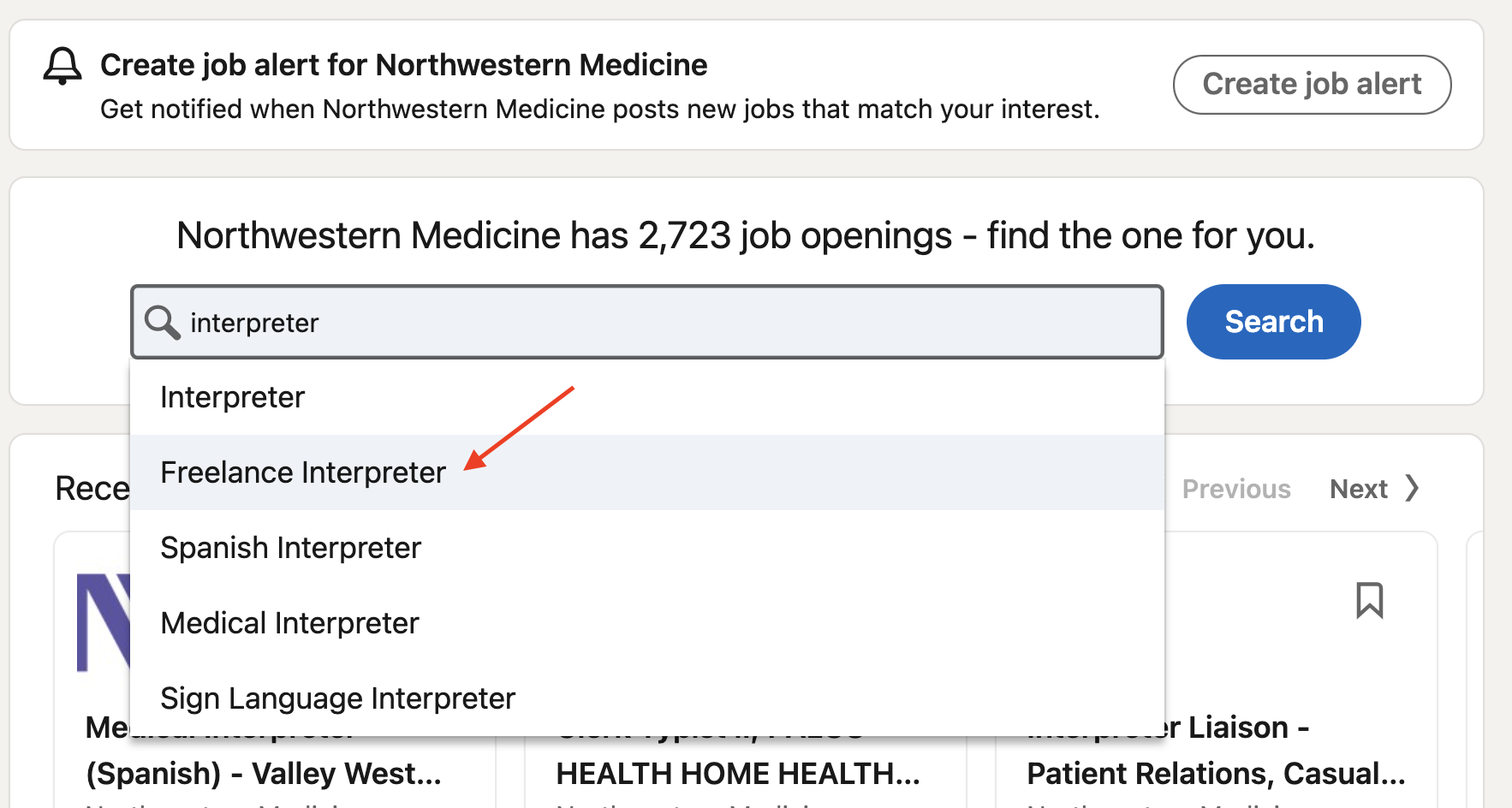LinkedIn Tips for Interpreters
Translators and interpreters who use LinkedIn know that they can connect with colleagues there pretty easily. But, of course, the goal is usually to connect with more clients.
The problem most freelancers face is they're not sure where to start or what will be the most effective use of their time on a professional networking platform like LinkedIn.
While many strategies are effective for both translators and interpreters (you can find out more about those by checking out Find Better Clients with LinkedIn), there are certain things interpreters can do to make their profiles more visible and attractive to potential customers.
Here's a breakdown of my top LinkedIn tips for interpreters. Even if you commit to just half of these, your LinkedIn presence and visibility will improve over time.
LinkedIn Profile Tips for Interpreters
Update your headline to include key information people are actually searching for.
Sounds obvious and overly simplistic, right? Well, it is and it isn't.
Did you know that your LinkedIn headline is one of the most searchable parts of your profile?
As an interpreter, you might only be willing to work within a certain geographic location. Perhaps you offer your services in a certain area or region (in addition to any remote interpreting you do). It's important for people to know this, and it makes it easier to find you in a LinkedIn or Google search if you already have this information in your headline (the text directly under your name on your profile).
In addition to your location, it's smart to include your language pair (in whole words since abbreviations like these are not easily searchable) and your preferred mode(s) and/or services. You might even include the types of settings where you prefer to interpret.
Here are a couple of excellent examples of effective headlines from interpreter colleagues.
Update your About section to speak to your clients and not just about yourself.
Your About section is the second most important part of your profile after your name/headline. It's highly searchable in terms of keywords, and it’s how potential clients can learn more about you and whether it would be a good fit to work together.
Use terms your clients would use in this section, not the jargon we translators and interpreters would use. Instead of sharing all about yourself (I know, it sounds counterintuitive, but trust me!), talk to your potential customers. Tell them exactly who you work with and how you solve problems. Show them how you help clients overcome challenges and achieve goals with your services.
If you're an interpreter who prefers to work remotely, make sure your About section reflects this. If you're willing to work in other cities and bring your own equipment along, say so. By spelling these things out, your clients don't have to guess. And you can more easily share the added value they'll receive by working with you.
Engage with video.
It's important for your interpreting clients to hear you speak. They want to make sure you speak clearly and that they’ll be able to hear you well. What better way to do this than to show them?
Include a video or a series of videos on your profile by including them in posts. Update them frequently or add them to LinkedIn articles so they stay near the top of your profile. Clients want to know how you speak and what it might be like to work with you, and a video is a great way to share your expertise and professionalism.
Note your professional affiliations.
If you belong to professional groups or associations, make sure you note these on your profile. You can do this in a few ways: mention it in your About section, add any volunteer work to the section called "Volunteering," or join a Group that belongs to one of these professional entities so it is listed under your "Interests." While most clients are not necessarily searching for this kind of information on your profile, it can definitely help to reinforce the idea that you are a professional who stays informed and involved in your profession by participating in such organizations.Certified or licensed? Say so (in the right place!).
Did you know that there is a section of your LinkedIn profile where you can list your certifications and licenses? Many of the students I talk to aren't aware, so I wanted to make sure to include it here. Scroll down in your profile to this section, and add any information that pertains to your credentials.Make sure to use the name of the issuing organization as it appears on LinkedIn if they have a presence there since this will connect you to that organization and will also allow you to use their logo on this area of your profile. Note the issue date, whether the credential expires, and your credential ID. You can even add a URL so potential customers can verify your credential on the issuing organization's website.
Update your Skills section.
The Skills section of your LinkedIn profile is easy to bypass. You might think, "Are people really scrolling that far? Does it matter?" While people may not be scrolling and reading every part of your profile, the Skills section is incredibly important. Not only are skills searchable on LinkedIn, but the more endorsements you have for certain skills, the higher your chances of getting discovered for them when someone conducts a search for a professional like you.
Share your skills, take the skills quizzes, and update your Skills section frequently. Did you know you can add up to 50 skills? This is a section of your profile where you'll want to spend some time so you can be sure to include skills that clients would appreciate in a professional interpreter. Don't forget to ask people to endorse you for your skills, too!
For a deeper dive into LinkedIn skills and how they can boost your profile, check out my post on LinkedIn endorsements and recommendations.
LinkedIn Networking and Job Alerts for Interpreters
Hang out where your clients do.
This sounds like a no-brainer, but I'm always shocked at how few colleagues do this. Hanging out where your clients do online isn't all that hard. How does it work on LinkedIn, though? The answer is easy… join client-facing groups. Most interpreters I work with on their LinkedIn presence are in colleague-facing groups only. This is great, but not if you want to be showing up where your clients are.LinkedIn Groups are a gold mine for finding the right people to connect with who may be hiring or who may know someone who needs an interpreter. So, don't be shy. Join groups that fit the markets you want to serve and start connecting with other group members.
Not sure where to start? I've written a post on how LinkedIn Groups work and how to use them to meet the right clients for you.
Set and tweak job alerts to hear about the latest remote or contract jobs!
Job alerts are plentiful when it comes to organizations looking to hire interpreters. In fact, I get far more alerts for interpreters (who are often mistakenly called translators by hiring entities on LinkedIn) than translators.When you set your job alerts for interpreting positions and roles, make sure you also set them for the word "translator!" Sure, we know which is the right word, but let's not let that stop us from hearing about an excellent opportunity because we know that many clients are searching with the wrong word. Use this to your advantage and you may just find more work as a result.
If you walk away with nothing else from this blog post, do yourself a favor and tweak your LinkedIn settings to set up job alerts strategically.
Follow companies to do better market research.
Just as you can join LinkedIn Groups and connect with potential customers directly on LinkedIn, you can follow companies you would like to work for as part of your overall strategy. Why is this important? LinkedIn's Company feature allows organizations to set up a profile, which is very similar to an individual's profile.
Companies can share posts, job openings, and more. And not only that, but you can often find a list of people who work at the company because they've noted this on their own profiles and are therefore connected with and listed under the Company's profile. Here's an example of what these items look like on a real LinkedIn Company page. This feature is another gold mine on the platform if you ask me!
While lots of the tips I've shared here can be useful to translators, too, I find that interpreters have a bit of an advantage when it comes to being able to stand out with their profile and find remote work. Make a commitment to work on your LinkedIn presence a little bit every week, and I'm sure you'll see the benefits.
Want to work with me on your LinkedIn profile and strategy? Book a 1-on-1 consultation with me, or sign up for Find Better Clients with LinkedIn!






